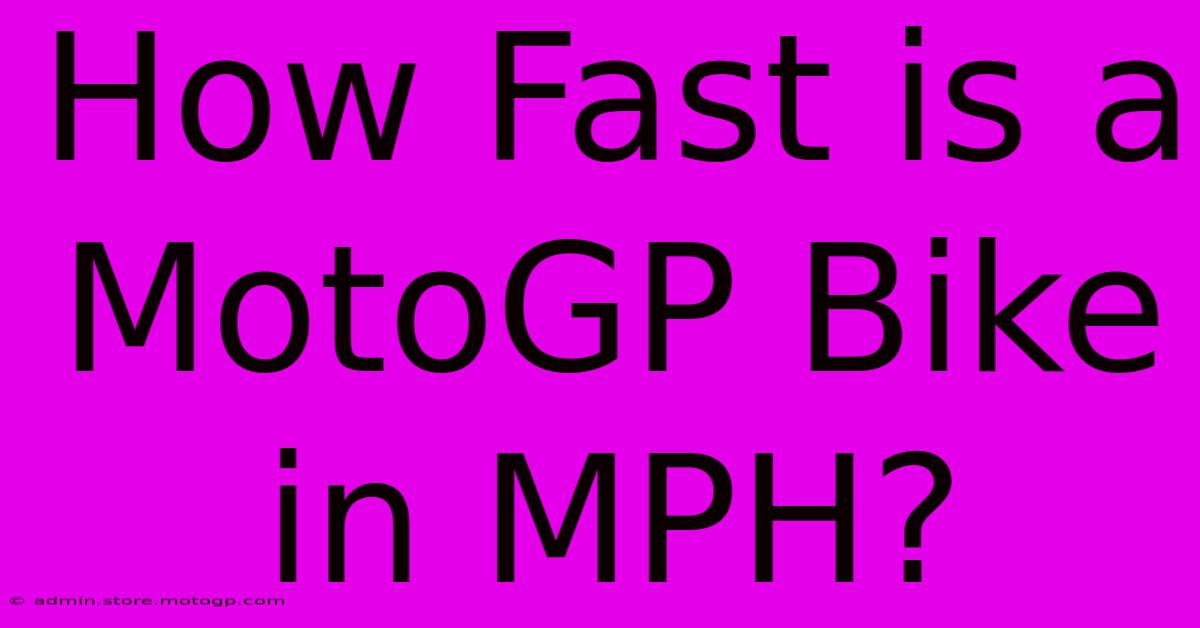How Fast Is A MotoGP Bike In MPH?

Table of Contents
How Fast is a MotoGP Bike in MPH?
MotoGP bikes are among the fastest motorcycles on the planet, boasting incredible speeds that leave spectators breathless. But just how fast are they, really? Let's dive into the exhilarating world of MotoGP speeds and explore the factors that contribute to their breathtaking performance.
Top Speed of a MotoGP Bike
The top speed of a MotoGP bike isn't a fixed number. Several factors influence it, including:
- Track layout: Long straights allow bikes to reach their maximum potential, while twisty circuits limit top speed.
- Aerodynamics: The bike's aerodynamic design plays a crucial role. Every little detail, from the fairing to the wings, affects its ability to cut through the air.
- Engine power: The powerful engines, exceeding 240 horsepower, are the main driving force behind these incredible speeds.
- Rider skill: A skilled rider can maximize the bike's potential, achieving higher speeds through precise control and optimal gear selection.
- Weather conditions: Wind and temperature can subtly affect top speed.
While it's difficult to give a single definitive answer, MotoGP bikes routinely exceed 200 mph (322 km/h) on long straights. Some circuits, with particularly lengthy straights, have even seen speeds approaching 220 mph (354 km/h) under ideal conditions. However, the average speed throughout a race is significantly lower due to corners and braking zones.
Factors Affecting MotoGP Bike Speed
Let's delve deeper into the key factors affecting a MotoGP bike's speed:
1. Engine Power and Technology: MotoGP bikes utilize highly sophisticated, four-stroke engines with cutting-edge technology. These engines produce immense power, allowing the bikes to accelerate rapidly and reach incredibly high speeds. Continuous advancements in engine technology lead to incremental speed increases each season.
2. Aerodynamics: The aerodynamic design of the bikes is paramount. Fairings, wings, and other components are meticulously designed to minimize drag and maximize downforce. This enables the bikes to remain stable at high speeds and even achieve higher top speeds. The constant development in aerodynamics plays a significant role in the pursuit of greater speed.
3. Tire Technology: The tires used in MotoGP are crucial for handling the immense forces generated at high speeds. These specialized tires provide exceptional grip and stability, allowing riders to push the bikes to their limits.
4. Rider Skill: A skilled MotoGP rider is essential for maximizing the bike's speed potential. Smooth throttle control, precise braking, and optimal gear selection all contribute to achieving the highest possible speeds.
Comparing MotoGP Speeds to Other Racing Categories
To put the speeds of MotoGP bikes into perspective, let's compare them to other racing categories:
- Formula 1: While F1 cars have higher top speeds on long straights, the nature of the track, with numerous corners, results in lower average race speeds compared to MotoGP.
- Superbikes: Superbike motorcycles are significantly slower than MotoGP bikes, due to less powerful engines and less advanced technology.
Conclusion: The Thrill of MotoGP Speeds
The sheer speed of MotoGP bikes is a testament to engineering excellence and rider skill. While the exact top speed varies depending on numerous factors, speeds exceeding 200 mph are commonplace, creating a thrilling spectacle for fans around the world. The constant pursuit of innovation in engine technology and aerodynamics ensures that these incredible speeds will continue to push the boundaries of motorcycle racing. The next time you watch a MotoGP race, remember the incredible speed and engineering marvel behind these amazing machines.

Thank you for visiting our website wich cover about How Fast Is A MotoGP Bike In MPH?. We hope the information provided has been useful to you. Feel free to contact us if you have any questions or need further assistance. See you next time and dont miss to bookmark.
Featured Posts
-
Moto Gp Bike For Sale Pure Racing Power
Feb 17, 2025
-
The Future Of Racing Grand Prix Red Bull Leads The Way
Feb 17, 2025
-
Moto3 Bikes Take Your Riding To The Next Level
Feb 17, 2025
-
Cota Qualifying The Cota Qualifying Handbook
Feb 17, 2025
-
Malaysia Moto Gp A Journey Into The World Of Racing
Feb 17, 2025
